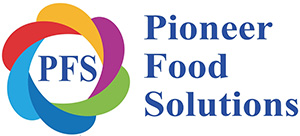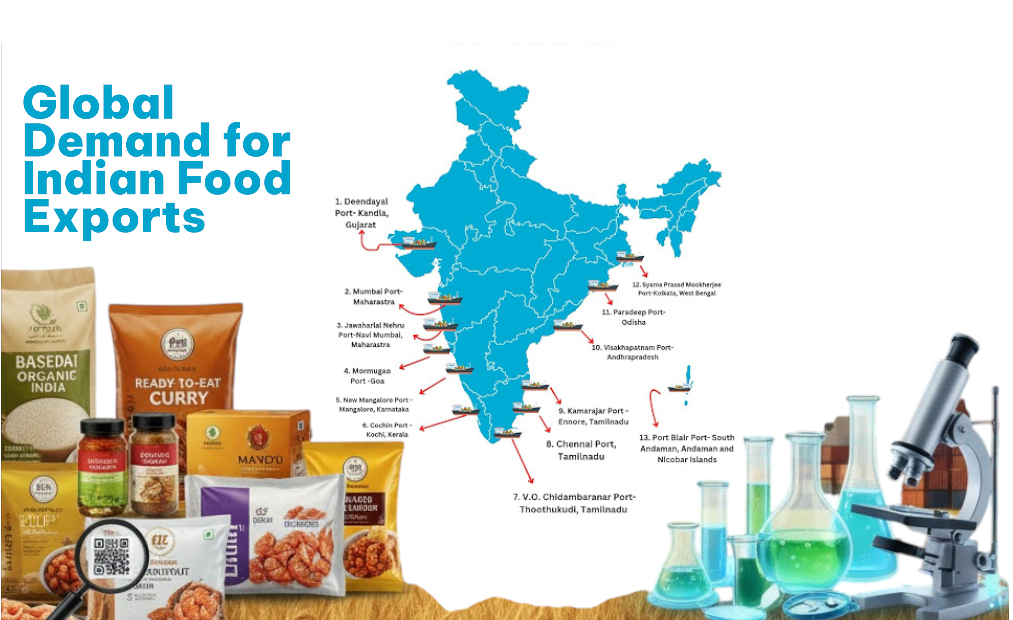🌾 Global Demand for Indian Food Exports: Top Markets & Untapped Opportunities in 2025
India’s food export sector driven by global demand, strategic policy shifts, and emerging market trends.
India has emerged as one of the top five agricultural exporters in the world, thanks to strong supply chains, testing infrastructure, and government support through APEDA (Agricultural and Processed Food Products Export Development Authority).
In FY 2024-25, India exported over $50 billion (₹4.15 lakh crore INR) worth of agri and processed food products, including rice, spices, mango pulp, ready-to-eat meals, and organic food. With global consumers increasingly seeking authentic and traceable products, the next decade will be crucial for Indian food exporters to target new high-potential regions.
Agricultural & Processed Food Exports – FY 2024–25
| Product Category | Export Value (USD Million) | Export Value (₹ Crore) | Major Export Destinations |
|---|---|---|---|
| Marine Products | 2,681.19 | 22,37.8 | USA, Japan, South Korea, UAE |
| Spices | 654.71 | 5,46.5 | USA, Germany, UAE, Saudi Arabia |
| Basmati Rice | 337.10 | 2,81.3 | Saudi Arabia, Iraq, Iran, UAE |
| Miscellaneous Processed Items | 251.93 | 2,10.4 | USA, UK, Germany, UAE |
| Dairy Products | 205.32 | 1,71.5 | UAE, Saudi Arabia, Bangladesh, Nepal |
| Ayush & Herbal Products | 188.55 | 1,57.5 | USA, Germany, UK, UAE |
| Processed Fruits & Juices | 161.42 | 1,34.7 | USA, UK, UAE, Germany |
| Cereal Preparations | 161.38 | 1,34.6 | UAE, Saudi Arabia, USA, UK |
| Castor Oil | 119.65 | 9,98.6 | China, USA, Japan, Germany |
| Processed Vegetables | 112.83 | 9,42.2 | USA, UAE, UK, Germany |
Total Exports: ~$49.4 billion ≈ ₹4.13 lakh crore
Agricultural & Processed Food Exports: FY 2025–26 Overview
Export Performance Q1
- April–June 2025: Exports reached $5.96 billion, marking a 7% year-on-year increase. This growth was driven by strong shipments of rice, buffalo meat, and fruits & vegetables.
Global Snapshot: India’s Food Export Strengths
India’s reputation as the “kitchen of the world” comes from its diversity and regulatory strength. Key export achievements under APEDA and EIC include:
- Rice exports: Over 22 million tonnes annually, both basmati and non-basmati.
- Spices: India contributes 45% of global spice trade volume.
- Processed & ready-to-eat foods: Growing at 12–14% CAGR, led by frozen and retort foods.
- Marine exports: India is among the top shrimp suppliers to the USA and EU.
Top Countries Importing Indian Food and Agri Products
| Rank | Country | Key Imports | Market Insights |
|---|---|---|---|
| 1 🇺🇸 | United States | Basmati rice, spices, RTE meals | Strong demand from Indian diaspora; preference for clean-label, vegan, and gluten-free foods. |
| 2 🇦🇪 | UAE | Rice, meat, snacks | Major re-export hub for GCC and Africa. |
| 3 🇧🇩 | Bangladesh | Grains, vegetables, pulses | Relies on Indian supply for food security. |
| 4 🇨🇳 | China | Marine products, oilseeds, spices | Rising interest in organic and herbal ingredients. |
| 5 🇸🇦 | Saudi Arabia | Basmati, meat, dairy | Long-term demand for premium quality and Halal certification. |
| 6 🇻🇳 | Vietnam | Spices, grains | Growing food-service and snack industries. |
| 7 🇬🇧 | UK & EU | Organic food, mangoes, ready meals | High-value market demanding strong traceability and sustainability compliance. |
Untapped & Emerging Markets for Indian Food Exports
While traditional destinations remain strong, new regions are rapidly opening to Indian food and agri products:
| Region | Opportunity Size | Products in Demand |
|---|---|---|
| Africa (Kenya, Nigeria, Ghana) | Import growth 7–8% annually | Affordable staples, fortified foods, instant meals |
| Latin America (Mexico, Brazil, Chile) | Increasing interest in herbal teas, ethnic foods | Spices, ready-to-cook sauces, organic products |
| Central Asia (Kazakhstan, Uzbekistan) | Dependence on imports | Pulses, grains, edible oils |
| Eastern Europe (Poland, Romania) | Food imports rising post-COVID | Frozen foods, RTE meals, pulses |
| Southeast Asia (Philippines, Thailand) | Indian cuisine trending | Spice blends, condiments, frozen curries |
Why Quality Testing & Certification Drive Export Success
Export readiness today depends on scientific validation and certification.
India’s export ecosystem is supported by three key pillars:
| Authority | Number of Labs (Approx.) | Testing Scope |
|---|---|---|
| FSSAI (Food Safety and Standards Authority of India) | 222+ | Food safety, hygiene, additives, contaminants |
| EIC (Export Inspection Council) | 78+ | Export inspection, marine, agri, processed foods |
| APEDA (Agricultural & Processed Food Products Export Development Authority) | 186+ | Pesticide residue, microbiology, organic certification |
These labs are NABL-accredited under ISO/IEC 17025 and ensure that Indian exporters meet EU, USFDA, and GCC import standards.
Exporter Strategies for 2025
- Adopt Traceability Systems: Blockchain or QR-based tracking for consumer trust.
- Obtain Key Certifications: FSSAI, HACCP, ISO 22000, Halal, Organic, Vegan.
- Invest in Packaging Innovation: Shelf-stable, recyclable, and retort formats boost global shelf presence.
- Leverage APEDA & DGFT Incentives: Use export schemes for lab testing and trade show participation.
- Build Brand India Storytelling: Authentic regional identity and clean-label positioning resonate globally.
- Strategic Considerations for Exporters To leverage the benefits of these FTAs, Indian exporters should: Understand Tariff Schedules: Familiarize themselves with the specific tariff reductions and rules of origin criteria under each agreement. Ensure Compliance: Adhere to the standards and regulations stipulated in the agreements to qualify for preferential treatment. Engage with Trade Bodies: Collaborate with industry associations and government agencies to stay informed about updates and opportunities related to FTAs.
- ⚠️ Challenges and Outlook > U.S. Tariffs: The World Bank warns that higher U.S. tariffs on Indian exports could slow South Asia’s growth in 2026, potentially affecting agricultural exports. Domestic Inflation: Rising domestic prices may impact the competitiveness of Indian agricultural products in international markets. Infrastructure Needs: Continued investment in logistics and cold chain infrastructure is essential to maintain export growth.
The Road Ahead
The global appetite for Indian food is expanding — from New York cafés serving masala chai to Kenyan supermarkets stocking ready-to-cook biryanis.
With APEDA and EIC and FSSAI compliance, India has built a robust foundation for food traceability and credibility.
The next growth frontier lies in Africa, Latin America, and Eastern Europe — regions where Indian food can combine price advantage with quality assurance.
Pioneer Food Solutions compliance management (Regulatory & Quality ) and Smart Food Lab (Product Innovation and Shelf life data)continue to support Indian exporters with — empowering brands to go global with confidence. Customer Request Form – Pioneer Food Solutions
#Indian food export markets, #APEDA exports, #FSSAI testing, #EIC certification, #agri exports from India, #emerging food markets, #Indian processed food exports, #export opportunities 2025, #agricultural testing labs India

